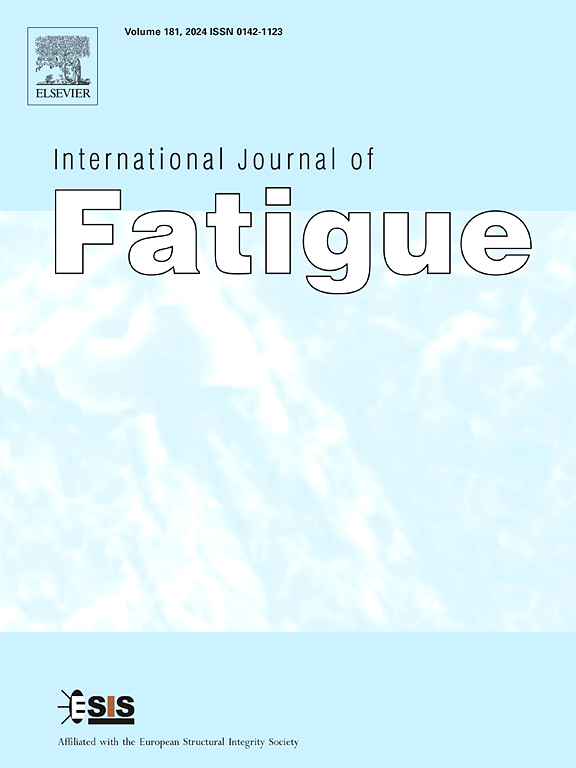Fatigue failure and grain refinement strengthening mechanism of aluminum alloy weld
IF 5.7
2区 材料科学
Q1 ENGINEERING, MECHANICAL
引用次数: 0
Abstract
A comprehensive understanding of fatigue failure and grain refinement strengthening mechanisms in aluminum alloy welds is crucial for improving their fatigue performance. This study proposes a novel macro–micro multiscale modeling method based on realistic microstructures and combines a dislocation-based crystal plasticity finite element model (CPFEM) with continuous fatigue damage theory. Through this approach, the fatigue crack propagation process and grain refinement strengthening mechanisms in laser-welded aluminum alloys are systematically investigated. The results reveal that fatigue crack propagation predominantly involves mixed fracture modes, with transgranular fracture being dominant and intergranular fracture secondary. High-stress regions at crack tips activate slip systems, significantly increasing cumulative slip and dislocation density, driving localized plastic deformation and promoting crack growth. Grain refinement enhances fatigue resistance through synergistic effects of grain boundary strengthening and dislocation strengthening. As grain size decreases, stress concentrations at crack tips are dispersed, broadening high-stress regions and enhancing crack resistance through grain boundary strengthening. Concurrently, grain boundaries hinder dislocation glide, leading to increased dislocation accumulation and interactions, which enhances resistance to crack propagation. Additionally, smaller grains lead to higher stored energy density, increasing energy dissipation and delaying crack growth. These findings provide valuable insights into fatigue failure mechanisms and practical strategies for enhancing the fatigue performance of aluminum alloy welds.

铝合金焊缝疲劳失效及晶粒细化强化机理
全面了解铝合金焊缝的疲劳破坏和晶粒细化强化机制对提高铝合金焊缝的疲劳性能至关重要。本研究提出了一种基于真实微观结构的宏微观多尺度建模方法,将基于位错的晶体塑性有限元模型(CPFEM)与连续疲劳损伤理论相结合。通过该方法,系统地研究了激光焊接铝合金疲劳裂纹扩展过程和晶粒细化强化机制。结果表明:疲劳裂纹扩展主要以跨晶断裂为主,沿晶断裂次之;裂纹尖端的高应力区激活滑移系统,显著增加累积滑移和位错密度,驱动局部塑性变形,促进裂纹扩展。晶粒细化通过晶界强化和位错强化的协同作用增强了材料的抗疲劳能力。随着晶粒尺寸的减小,裂纹尖端应力集中逐渐分散,高应力区逐渐扩大,通过晶界强化增强抗裂能力。同时,晶界阻碍了位错滑动,导致位错积累和相互作用增加,从而增强了对裂纹扩展的抵抗力。晶粒越小,存储能量密度越大,能量耗散越大,裂纹扩展越慢。这些发现为进一步研究铝合金焊缝的疲劳失效机理和提高其疲劳性能提供了有价值的思路。
本文章由计算机程序翻译,如有差异,请以英文原文为准。
求助全文
约1分钟内获得全文
求助全文
来源期刊

International Journal of Fatigue
工程技术-材料科学:综合
CiteScore
10.70
自引率
21.70%
发文量
619
审稿时长
58 days
期刊介绍:
Typical subjects discussed in International Journal of Fatigue address:
Novel fatigue testing and characterization methods (new kinds of fatigue tests, critical evaluation of existing methods, in situ measurement of fatigue degradation, non-contact field measurements)
Multiaxial fatigue and complex loading effects of materials and structures, exploring state-of-the-art concepts in degradation under cyclic loading
Fatigue in the very high cycle regime, including failure mode transitions from surface to subsurface, effects of surface treatment, processing, and loading conditions
Modeling (including degradation processes and related driving forces, multiscale/multi-resolution methods, computational hierarchical and concurrent methods for coupled component and material responses, novel methods for notch root analysis, fracture mechanics, damage mechanics, crack growth kinetics, life prediction and durability, and prediction of stochastic fatigue behavior reflecting microstructure and service conditions)
Models for early stages of fatigue crack formation and growth that explicitly consider microstructure and relevant materials science aspects
Understanding the influence or manufacturing and processing route on fatigue degradation, and embedding this understanding in more predictive schemes for mitigation and design against fatigue
Prognosis and damage state awareness (including sensors, monitoring, methodology, interactive control, accelerated methods, data interpretation)
Applications of technologies associated with fatigue and their implications for structural integrity and reliability. This includes issues related to design, operation and maintenance, i.e., life cycle engineering
Smart materials and structures that can sense and mitigate fatigue degradation
Fatigue of devices and structures at small scales, including effects of process route and surfaces/interfaces.
 求助内容:
求助内容: 应助结果提醒方式:
应助结果提醒方式:


